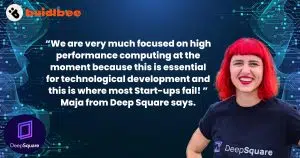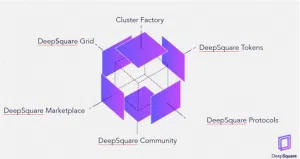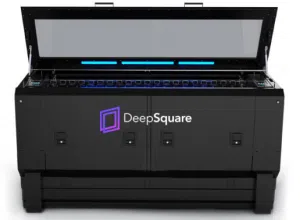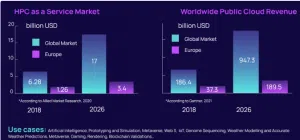Contents
They are building the Layer-0 infrastructure of Web3 technology and trying to do so sustainably.
What is DeepSquare?
DeepSquare is a company that provides sustainable high-computation power to their community, locally and across their international Web3 ecosystem. Their goal is to provide the fastest and most efficient computation power while reducing their impact on the environment as far as possible.
DeepSquare achieves its goal of reducing its carbon footprint by using renewable energy sources from its reused power; this is collected from its computation servers. This method not only reduces the overall energy waste but also enables their system to operate more effectively and for cheaper.
The brand new newsletter with insights, market analysis and daily opportunities.
Let’s grow together!
DeepSquare uses cutting-edge technology to improve the efficiency of its computation process to optimize its energy use further. Team Square has developed advanced algorithms to optimize how computational resources are reallocated, ensuring that the grid words are as effective as possible.
Another key focus of DeepSquare is true transparency and open collaboration. They have been very generous with their research and allowed their development findings with their community. They often collaborate or share their research with other companies to achieve sustainable and accessible high-performance computation power.
If you want to know more about DeepSquare, their white papers read like a road map to greatness.
What problems does DeepSquare solve in the Cloud Computing industry?
There is a current issue with the overconsumption of energy in the world and climate change caused by various facts that impact the environment negatively. This is a problem that is very prevalent in the cloud computing service industry. The High-Performance Computing process (HPC) has a very high demand for energy, which negatively impacts the environment.
When someone tells you like a data center, the first thing that pops into your mind is this huge data-centered, huge building, like a huge fridge for servers. This is not what we are doing. We are doing this on a smaller scale but with very powerful supercomputers. We power them with renewable energy, but this is not enough. So sustainability is a way more complex issue than just energy or power usage. So, we are doing it using an immersion cooling system; this is a practice of dipping your hardware into non-conductive liquid.
That later on also enables us to capture all the heat because supercomputers are extremely efficient in computation but also are efficient in transforming electricity into heat. And we are now able to capture the heat and reuse it. So two of the clusters we have up and running in Switzerland are connected to the district heating network.
This means that while you, as an AI engineer, are working on our platform and developing a new vaccine using AI, someone in Switzerland has a hot shower without any additional coil or whatever is burned. So, instead of wasting it, we are reusing it. Maybe just to put things into context, there is this thing called the theory, a power usage effectiveness indicator used in data centers. It tells you, basically, from 100% of the energy you take from the grid. — Maja, head of Marketing at DeepSquare.
To solve this issue, DeepSquare is creating a new standard for sustainable cloud computing and how to minimize this industry’s impact on the environment. They use methods such as specialized hardware to achieve this goal:
- Two of these methods connect high-performance computers to a grid on which they recycle wasted computation power.
- They use a hardware cooling system to capture and reuse heat produced by the supercomputers.
The second problem that DeepSquare plans is to bring transparency and decentralization to the field of cloud computation. The current cloud computing industry is monopolized by 5 corporations. These companies do not have the incentive to be transparent with the larger market. The centralization of the industry reaffirms the negative practices in the industry due to their lack of accountability to their clients, including companies that build their projects on top of the cloud computing infrastructure.
DeepSquare is actively working to create an interoperability layer between all the computation resource providers to allow multiple companies to operate together and build a Web3 ecosystem created “for the people by the people.” Their goal is to allow each country to have its own grid of high-performance computers that will allow them to operate while free of any external limitations from large, centralized cloud computing servers.
If you want to connect with the DeepSquare team (Team Square), reach out to them directly through either Telegram, Twitter, or Instagram.
What is the layout of the DeepSquare project:
DeepSquare was created to combat issues linked to centralization of computation resources. Their ultimate goal is to take a resource as valuable as high-performance computation and put it in the hands of as many people as possible so that the elite minority no longer monopolizes it.
DeepSquare is building a decentralized, trustless, and sustainable ecosystem that is blockchain-powered, designed to benefit the masses, and fundamentally community-led and governed through the DeepSquare token owners within the ecosystem.
DeepSquare has 6 facets of its community:
- DeepSquare Grid — the interoperability layer that consists of a cluster of computing servers that can host supercomputers.
- Cluster factory — This modular software stack offers a plug-and-play option for anyone wishing to join a DeepSquare grid.
- DeepSquare community — This comprises all actors in the DeepSquare ecosystem (Dapps, Independent Software Vendors (ISVs), digital service providers, blockchain and crypto developers, etc.
- DeepSquare Compute Protocol — have a proof of stake (PoS) blockchain (DeepSquare owns a subnet on Avalanche) that regulates the ecosystem interactions. They also incorporate a proof of computing (PoC) proof type that ensures that all parties operate transparently and by the same rules as all other parties.
- DeepSquare Marketplace — this marketplace is full of ready-to-use applications and services in Web3. This marketplace is the first visible product on the DeepSquare grid and serves as a place for Independent Software Vendors to sell their digital products and services and Dapps on the DeepSquare grid.
- DeepSquare two-token model — DeepSquare utilizes two tokens, DPS (DeepSquare tokens) and SQUARE tokens, in their ecosystem.
How does DeepSquare make high-performing computing more sustainable?
DeepSquare utilizes renewable energy sources and advanced algorithms to optimize the allocation of high-performance computational resources. This allows the DeepSquare ecosystem to minimize its environmental impact through efficiency and reducing waste.
There is a specific quality that sets DeepSquare apart from other companies in their field: their devotion to collaboration and transparency. They take it so far as to help other companies in their industry reduce their own computation resource waste and environment. This is why the DeepSquare team regularly shares their research and development with the broader community, universities included. The organization is devoted to advancing the field of high-performing computation power.
DeepSquare is also known for using cutting-edge technology like Green AI Chip to ensure that its processing grid is as efficient as possible. This company is truly driving innovation in the field of sustainable high-performance computation with its unique approaches to the field.
Immersion cooling
The company is known for its vision for a decentralized network of high-performance cloud computing services, but its infrastructure has far more use cases than that. All of this translates into an extreme volume of computation resources expended daily. This has a serious problem both for DeepSquare and for the environment. The solution is multifaceted, which DeepSquare utilizes to reduce its energy waste during the computation process.
The solution: immersion cooling.
Immersion cooling is not complex, but it is invaluable in the technology industry. It requires you to place your electronic hardware into a conductive but electronically resistive liquid to absorb the computer’s heat. The liquid is far more efficient than air when capturing heat from computing hardware. DeepSquare’s cooling efficiency allows it to densify top-quality hardware into just one of its SmartPods. Submer is a single-phase coolant that does not evaporate and must not be replaced as often. That heat is captured by the liquid and converted into heat energy and then placed onto the DeepSquare grid to be reused by the rest of the ecosystem. Smart coolant can last up to 20 years before needing to be replaced. The best part is that it is biodegradable and easily be recycled.
Heat reuse
Heat power waste is a continuous problem concerning high-performance computers (HPC). DeepSquare actively tries to resolve this challenge with its hardware cooling system. Immersion cooling reduces the heat waste produced by supercomputers and creates an opportunity for DeepSquare to reuse the heat captured by the cooling liquid. The cooling system from each cluster is connected to the existing plumbing system. It connects to a secondary cooling loop within the cluster that allows the energy produced from the collected heat energy to be efficiently reused by other hardware linked to the cluster.
Sustainable infrastructure growth
DeepSquare aims to deploy multiple sustainable clusters integrated into existing third parties computer providers and facilities that provide optimized hardware. Almost 60% of computing power is relocated on the cluster network, and the deployed infrastructure improves the environment it enters. Renewable energy sources entirely power the DeepSquare clusters, and this allows for the clusters to boast a near-carbon-neutral status with no carbon credits or offsets.
It is essential, given the different international realities regarding technological access. The current plan is to deploy these clusters in locations with mixed exposure to various renewable electricity sources; wind, hydro and solar. This, in combination with the immersion cooling system, with optimized hardware that utilizes 10-15% less metal and plastic, makes a more sustainable process overall. This process allows almost 100% of the heat to be reused!
What does Deep Square focus on?
We are looking to host all the innovators and all the startups because startups are basically at the forefront of technological development with the face. So, we are looking to host all of them and help them build their groundbreaking solutions. We’re looking to develop a mature, healthy, and functional community-led ecosystem in three years. — Maja Kehic, Head of Marketing
DeepSquare is a community-led ecosystem that utilizes its network to advance in these technology fields. The goal is to innovate and sustainably incorporate these technologies to make eco-conscious supercomputing resources available to the world.
Sustainable HPC (High-Performance Computing)
Sustainable HPC is the core focus of DeepSquare, and it is a fundamental part of their plans. Every year, the amount of energy produced on the planet is only ever increasing. The prediction is that it will only grow by 20% by 2030. This is why sustainable high-performance computing (HPC) is so essential. It has the potential to solve a wide range of problems in sectors such as science, engineering, healthcare, and business. Its main contributions are found in reducing energy consumption and environmental impact.
In standard data centers, an average of 38% of the energy is used for active cooling, while the remaining 62% is used for computation. From this process, heat energy waste is a significant problem. HPC is around 8 times more energy-intensive than general-purpose computing. In most data centers, over one-third of electricity consumption is attributed to inefficient air-cooled systems with a power usage effectiveness (PUE) of 1.59, which results in a significant amount of waste heat being released into the atmosphere.
Metaverse
The metaverse is an exciting new online world that connects the digital and physical realms, sometimes referred to as the “next generation of the internet.” Making the metaverse more efficient and fast-moving, people can interact in immersive 3D virtual environments, creating a sense of community beyond physical space. However, building and maintaining the metaverse requires massive computing power or high-performance computing (HPC). Many users rely on service providers like AWS to access the necessary HPC capabilities.
DeepSquare’s HPC as a service offers a decentralized alternative, giving users more control over their information and helping make the metaverse more efficient and fast-moving. Supercomputers are the metaverse engine, providing the massive amounts of computing power needed to run real-time processing of virtual assets and detailed rendering models for avatars, the digital representations of users. The HPC industry has seen significant growth in recent years, with the expansion of data centers worldwide. Ultimately, HPC will be critical in enabling people to exist and thrive in the metaverse.
Rendering
Rendering is creating a realistic or stylized image from a 2D, or 3D model using a computer program. It can be extremely demanding on a computer’s processing power, which is where high-performance computing (HPC) comes in. HPC has a lot of practical use cases: it would take a regular home computer around 10,000 years to render just 90 minutes of footage for an animated movie. With HPC, that same process can take as little as 6 weeks.
HPC is a driving force behind advances in video technology, and DeepSquare is taking things even further by abstracting hardware from the end user. This allows artists to focus on their craft and push their imagination to new limits without worrying about the technical side. In short, HPC allows creators to bring their visions to life in ways that would otherwise be impossible.
Artificial Intelligence
AI, including machine learning and deep learning, can be enhanced by HPC to achieve faster results. As AI models require more computing power, using parallel computing and modern accelerators, HPC plays a crucial role in their growth. By combining AI and HPC, we can solve some of the world’s most complex problems today, from training AI for autonomous vehicles to developing new treatments and vaccines for illnesses.
Using HPC to train AI enables businesses and research facilities to take advantage of both technologies, resulting in faster development of AI models while enjoying scalability, increased performance, and reduced cost. Data is becoming increasingly prevalent, and the volume of data transferred is growing exponentially. Intense computing tasks are often required to use this data, which is best suited to specialized HPC clusters. HPC solves complex problems in various industries, including aerospace, manufacturing, healthcare, finance, research, media, and entertainment.
Tokenomics:
DeepSquare has two native tokens with which their community can interact in their ecosystem. The DeepSquare tokens:
DeepSquare Tokens (DPS): DPS is the investment/asset token featuring staking, dividend, and voting rights on the DeepSquare blockchain ecosystem.
SQUARE tokens: This is the DeepSquare utility token. It is considered the fuel of the DeepSquare ecosystem. It can be traded on centralized and decentralized crypto exchange platforms with multiple trade pairs.
DeepSquare has 4 primary incentive mechanisms.
- Referral program
All parties in the ecosystem that hold a minimum of 25k DPS tokens are eligible to participate in the referable program. They will then receive a 12% commission for every token purchased by their direct referee. The referral program stops at the first degree of separation.
- Staking rights
DPS tokens also have a staking option for community actors with a holding minimum of 25k DPS tokens. Once they have staked DPS tokens on the DeepSquare ecosystem, token holders can receive their staking rewards in SQUARE instead of DPS.
These are the staking options available for token holders:
- 3 months — minimum APY of 4 %
- 6 months — minimum APY of 6 %
- 9 months — minimum APY of 8 %
- 12 months — minimum APY of 10 %
The tokens minted to reward stakers will be based on the total possible tokens eligible for staking with minimum return for the maximum commitment.
- Token model
The DeepSquare ecosystem utilizes a two-token model. The DeepSquare token (DPS) is a token that provides governance and ownership in the DeepSquare community and includes voting rights. The second token is the SQUARE token, a utility token that can be used for transaction fees and staking rewards, and this token is also available on DEX and CEX for trading.
- Smart contract
The DeepSquare business model is intrinsically linked to its tokenomics. They operate as a single entity that interacts with the DeepSquare ecosystem.
DeepSquare is in a private sales stage at this moment. And what you, as a potential investor, are getting now is a DeepSquare token (DPS). It’s an asset token. You become part of the DeepSquare community because DeepSquare is an association. The long-term vision of the project is for it to become community-led. We already had some practice, like voting. So, the DPS token gets you voting and staking rights and, as I’ve said, being a community member. On the other hand, we have a utility token that allows for stalking on the blockchain ecosystem for transaction fees. There are also staking rewards in place later. We haven’t had any votes yet. I believe we’ve had two voting events, with over 50% of holders getting involved. — Maja Kehic, Head of Marketing at DeepSquare.
How can I make money on this?
DeepSquare offers business-to-business services, and they are looking to expand their list of services with their multi-focus approach to machine learning, AI, rendering, and sustainable high-performance computing. These are three ways you can realize your inner tech visionary using DeepSquare infrastructure and technology:
- Join the DeepSquare grid and reduce the overuse of energy and computation waste of your project or company.
- Make use of rendering services as a gamer.
- Tap into their grid of HPCs (High-performance computers) to start your own Web3 project without having to buy expensive hardware.
That being said, the purpose of this article is not to sway you to use any particular blockchain network or partner with the subject of the article, in this case, DeepSquare. By reading this article, you should be empowered by the realization that you have the future at your fingertips and that if you can dream it, there is a Web3 start-up that will help you realize that dream. If there isn’t, this is your opportunity to create that start-up yourself!
If you want to know more about DeepSquare, feel free to read this article about an exclusive interview between the DeepSquare team and us!












